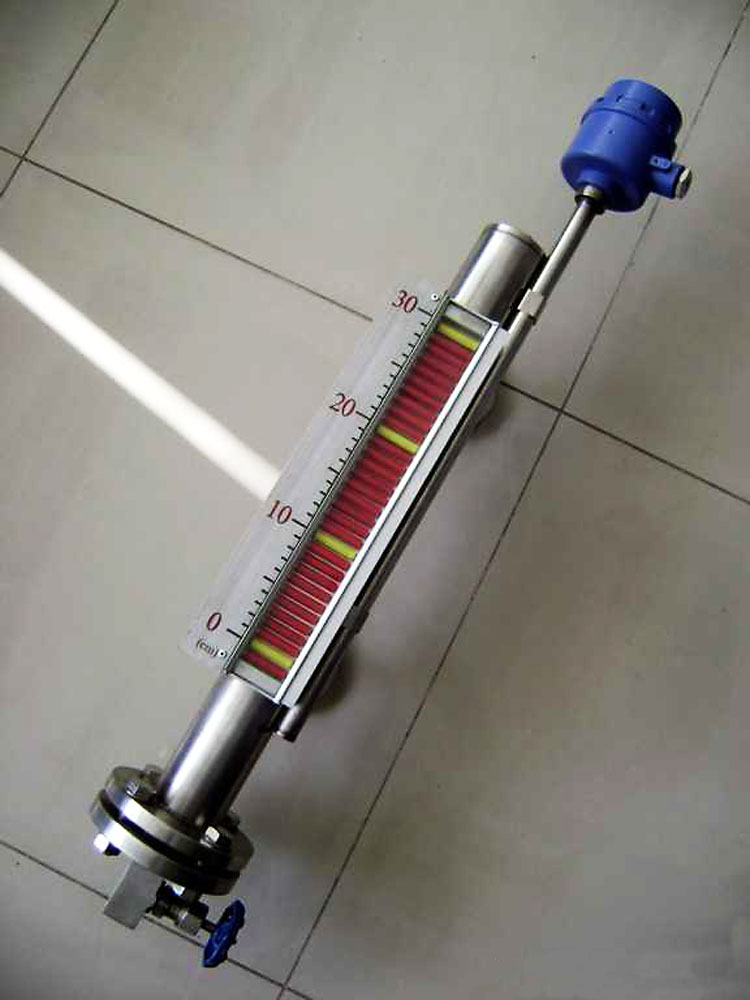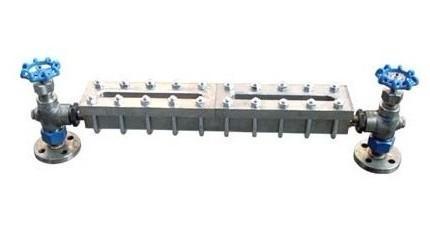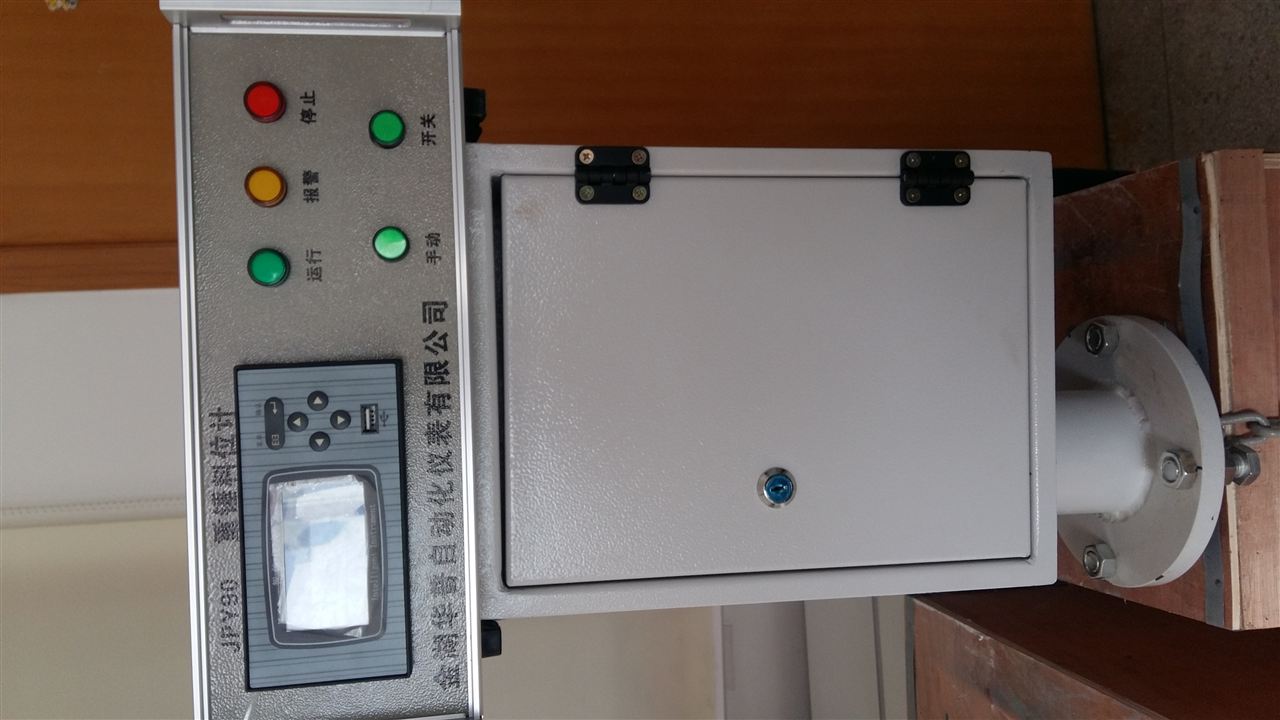Level gauge is to measure the height of liquid level in tank or tank, and it shows the height of liquid level inside. The use of liquid level is very extensive. The specific are: magnetic flap level gauge, glass tube level gauge, liquid level Transmitter, two-color quartz tube level gauge, buoy level gauge and so on. Let us introduce you to the working principle and application of various level gauges today. One, magnetic flap level gauge The main principle The magnetic column level gauge is also called magnetic flap level gauge. Its structure is mainly based on buoyancy and magnetic force principle. The position of the float with a magnet (referred to as a magnetic float) in the measured medium is affected by the buoyant force. The change of the liquid level results in the change of the position of the magnetic float, and the coupling of the magnetic float and the magnetostatic force of the magnetic tilt column (also called the magnetic flip plate) causes the magnetic tilt column to flip over a certain angle (the surface of the magnetic tilt column coats different colors), and reflects The level of fluid in the container. The electronic module and transmitter module, which is composed of sensors (reed switches) and precision electronic components, can transmit output resistance signals, current values ​​(4 to 20 mA), switching signals, and other electrical signals. In order to achieve the perfect combination of on-site observation and remote control. Application scope and characteristics With: simple structure, easy to use, stable performance, long service life, easy installation and maintenance. The magnetic column level gauge can be used for level measurement and control in various industrial automation process controls. Can be widely used in petroleum processing, food processing, chemical, water treatment, pharmaceutical, power, paper, metallurgy, shipbuilding and boilers in the field of liquid level measurement, control and monitoring. Second, magnetic float level gauge (level switch) The main principle The magnetic ball level gauge (liquid level switch) structure is mainly designed and produced based on the principle of buoyancy and static magnetic field. The position of a floating ball with a magnet (referred to as a floating ball) in the measured medium is affected by the buoyant force: a change in the liquid level results in a change in the position of the magnetic float. The action of the magnet and the sensor (reed switch) in the float ball causes the number of components (such as fixed-value resistors) connected in series to change, thereby changing the electrical quantity of the instrument circuitry. That is, the change in the position of the magnetic float causes a change in the amount of electricity. The level of liquid in the container is reflected by detecting the change in electrical quantity. The level gauge can directly output the resistance value signal, can also be used with the transmission module, output current value (4 ~ 20mA) signal; at the same time with other converters, output voltage signal or switching signal (can also be in accordance with customer demand Company delivery). In order to achieve the remote transmission, analysis and control of electrical signals. Application scope and characteristics The magnetic float level gauge can be applied to almost any level measurement and control in industrial automation process control, and can be widely used in petroleum processing, food processing, chemical engineering, water treatment, pharmaceutical, electric power, papermaking, metallurgy, shipbuilding and boilers, etc. Level measurement, control and monitoring in the field. Third, the glass level gauge Working principle and structure The glass plate type liquid level gauge is designed based on the principle of the communicator. The liquid path formed by the glass plate and the liquid level gauge body is connected to the measured container by a flange or a taper pipe thread to form a communicator, which is observed through the glass plate. The liquid level is the same as the liquid level in the container, that is, the height of the liquid level. The needle valve at both ends of the level gauge not only functions as a stop valve, but also has the function of a check valve in the internal steel ball. When the liquid level gauge accidentally breaks and leaks, the steel ball can automatically close the liquid passage under the action of the medium pressure. To prevent the large outflow of liquid for safety protection. The level gauge can change the material of the part or add some ancillary parts to achieve anti-corrosion, thermal insulation, anti-frost, lighting and other functions. Application scope and characteristics The glass plate level gauge has the advantages of simple structure, economy and practicality, convenient installation, reliable operation and long service life. As the basic liquid level indicator, this product is widely used in the measurement and monitoring of the liquid level in the most simple liquid level measurement occasions and large-scale automation projects. Fourth, heavy hammer detection level gauge The main principle Heavy hammer detection level gauge is designed and produced according to the principle of mechanical balance. When the strip is immersed in a stationary position in the liquid, the gravity of the float, wire rope (or strip), weight and pointer, the buoyancy of the liquid on the strip, and the system friction are in balance. When the liquid level changes, the buoyancy F will change accordingly, and the original balance of the system will be disturbed by the disturbance and will reach dynamic balance again. The change of the liquid level leads to the change of the position of the float, and the heavy hammer drives the pointer to move up and down. The change of the liquid level in the container can be clearly and intuitively displayed on the scale. The top of the scale plate indicates the zero of the liquid surface, and the bottom indicates the full scale of the liquid surface. The pointer changes with the change of the level, and continuously indicates the level of the liquid level. Application scope and characteristics The hammer detection level meter has the advantages of reasonable structure design, excellent performance, reliable operation, long service life, easy installation and maintenance, and reasonable price. Can be widely used in chemical, electric power, water treatment and other fields in the medium and large tanks of various liquids and high viscosity, corrosive liquid level under constant pressure conditions of continuous measurement. Fifth, ultrasonic level gauge working principle It is through an apparatus that can emit energy waves (generally pulse signals) that emit energy waves that encounter obstacles and are reflected by a receiving device that receives the reflected signals. The change of the level is determined by measuring the time difference of the energy wave motion process. The microwave signal is processed by the electronic device and finally converted into an electrical signal related to the material level. A probe transmits an ultrasonic pulse signal to the surface of the medium to be measured, and the ultrasonic wave encounters the measured medium (obstacle) after being reflected in the transmission process. The reflected ultrasonic signal is detected by the electronic module, processed by special software, and analyzed by the transmitted ultrasonic wave and back. The time difference of the wave, combined with the propagation speed of the ultrasonic wave, can accurately calculate the distance traveled by the ultrasonic wave, which in turn can reflect the situation of the level. Application scope and characteristics Can be used to automatically compensate for interference with steam, dust, moisture, in addition can be applied to liquid / solid, can also be used for uninterrupted material / liquid level control, tanks, storage tanks, uninterrupted material / level measurement storage room, granary Wait. Widely used in petroleum, chemical, water, sewage treatment, water conservancy hydrology, steel, coal, electricity, transportation and food processing and other industries. Six, smart radar level gauge The main principle: The smart radar level gauge is a kind of microwave level meter, which is an application of microwave (radar) positioning technology. It transmits energy waves through a device that can emit energy waves (typically pulse signals). The energy waves are reflected by obstacles, and a receiving device receives the reflected signals. The change of the level is determined by measuring the time difference of the motion of the energy wave. The microwave signal is processed by the electronic device and finally converted into an electrical signal related to the material level. In microwave level measurement equipment, the energy waves used are usually high-frequency electromagnetic waves with a frequency of 8.3 GHz (mostly around 6 GHz and also with higher frequencies). The energy wave used by this device is a pulsed energy wave. The maximum pulse energy of a typical pulse energy wave is about 1mW (average power is about 1μW), which will not cause radiation damage to other equipment and personnel. Application scope and features: The intelligent radar level gauge is used for non-contact continuous measurement of liquid, slurry and particulate material levels. It is suitable for applications where there are large variations in temperature, pressure, presence of inert gases or vapors. It uses microwave pulse (PTOF) measurement method and can work normally in the industrial frequency band. The beam energy is low, can be installed in various metal, non-metallic containers or pipes and has no harm to the human body and the environment. Has the following features 1, no blind area, high precision 2. Two-wire technology is an excellent alternative to differential pressure instruments, magnetostrictive, RF admittance, and magnetic flap instruments. 3, without pressure changes, vacuum, temperature changes, inert gases, smoke, steam and other environmental effects 4, easy to install, strong and durable, maintenance-free 5, the output signal is 4mA ~ 20mA/HART protocol, calibration is simple, easy to implement on-site calibration operation through digital liquid crystal display, simple configuration and programming through software 6, sensitive measurement, refresh speed. 7, suitable for high temperature conditions, up to 200 °C process temperature, when using high temperature extended antenna up to 350 °C. Graphite Crucible,Foundry Crucibles,Graphite Crucible Sizes,Graphite Crucible For Aluminum Henan Carbons New Material Technology Co., Ltd. , https://www.hncarbons.com




